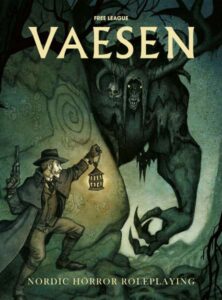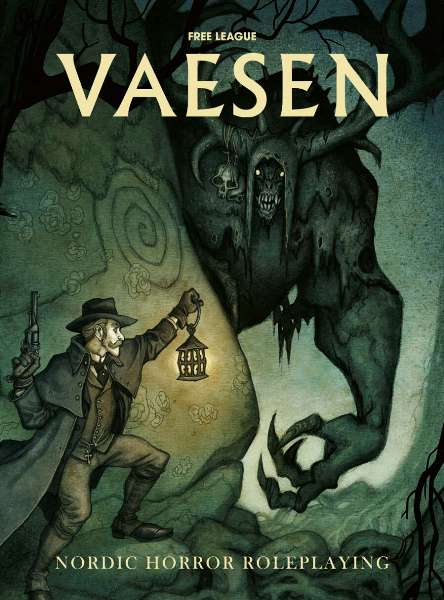
Vaesen
Vaesen is an investigative horror roleplaying game, written by Nils Hintze, Rickard Antroia, and Nils Karlen and published by Free League Publishing
By Aaron T. Huss

Learn more about Vaesen here
Purchase Vaesen here (paid link)
Find other Vaesen posts here
Vaesen is an investigative horror role-playing game set in a 19th century mash-up of Scandinavia filled with beings from Norse mythology. These mythological beings influence the world around them and can sometimes be felt, but they can only be seen by those with a special gift to do so, called The Sight. The PCs are part of a group with The Sight that can then address all manner of issues related to the mythological beings. It is powered by a modified version of the Year Zero Engine and sits on the lighter side of a rules-medium game. This is an important note that will be explored further as it influences the essence of gameplay. The setting is the Scandinavian countries, but Vaesen takes an open-minded approach to the 19th century whereas the dates things happen or become available is not really relevant; they can instead be mashed together to meet the needs of the game. The artwork is akin to what I’ve seen in steampunk settings, albeit without the steam technology, and utilizes muted colors to set the tone. Overall it is a beautiful blend of concepts that will be explored herein one by one.
To set the overall tone of the game is the investigative horror aspects of the game. It is not meant for the PCs to defeat the big bad but rather understand it and determine how to get rid of it in whatever means match that particular mythical being. Combat is more likely to be isolated to human conflicts as you can’t really kill the mythical beings. As such, the game focuses heavily on the discovery of clues that provide the PCs with the tools they need to be successful. Additionally, the game’s mechanics focus heavily on the storytelling aspects of these final conflicts rather than mechanical interpretations (e.g., weapons, hit points, fantasy magic, etc.). Additionally, each mythical being has an accompanying extensive write-up that allows the GM to wrap the story around every aspect of that being.
Matching the tone of the game are the different aspects of the setting and how they blend together – 19th century, Scandinavia, and mythology. Although mythology has been present throughout cultures across history, it is much more prominent and documented in some cultures versus others. The Scandinavian culture has a rich mythological history with stories passed down for generations. It is very approachable as much of it has been translated time and again into fantasy games and major settings. Being Norse mythology, it only makes sense to set the game in Scandinavia, but the blend of urban and rural throughout these countries during the 19th century are beneficial to creating a game focusing more on investigative conflict resolution than combat. Finally, setting it in the 19th century limits the technological advancements while still providing beneficial technology, supporting a more personnel resolution of conflicts rather than relying on technology to take over. Plus it embraces a desire to make the game focus on smaller and closer locales than the ability to globetrot.
Completing the game are the rules; a blend of mechanical and storytelling rules. Characters are a combination of abilities, skills, and talents that provide situational bonuses, but health is a combination of physical and mental conditions that create a hindrance once wounds are incurred. This is a brilliant blend of mechanical and storytelling aspects to represent physical and mental strength as the game goes on. Magic is only in the hands of the mythical beings and oftentimes they are utility in nature as opposed to the very mechanical aspects of fantasy magic. The structure of an adventure is that of a mystery with moving parts in the foreground and background, both represented as storytelling elements that can affect the direction and haste of the PCs. Mythical beings have similar health that is represented by different conditions that are primarily storytelling elements with either mechanical or story hindrances attached to each one. The best part is that each mythical being has a completely different set of conditions that marry to the essence of what makes that being unique. In the end, however, there is only one way to defeat the mythical beings and that requires the group to discover the secrets of that being. Otherwise the beings generally comeback or create havoc upon disappearing. The mechanical parts of the game are more for adding tension to resolving conflicts, puzzles, and investigations. Not everything can be an automatic success!
As a fan of Call of Cthulhu and Trail of Cthulhu, I really like Vaesen. I like the blend of mechanics and storytelling elements with a focus on solving the mystery using narrative methods to keep the game exciting and not bogged down in dice rolls, bonuses and penalties, and target numbers. But then, I do find myself preferring fewer mechanics the older I get and Vaesen really hits that sweet spot!

